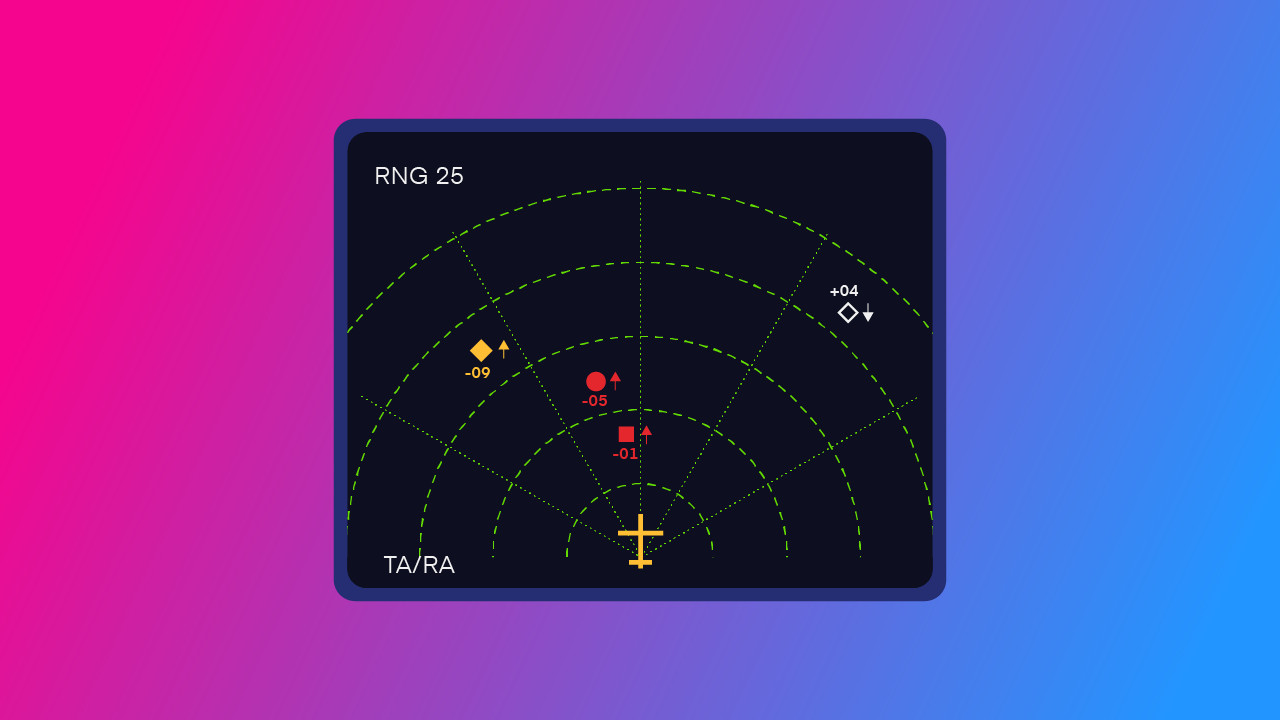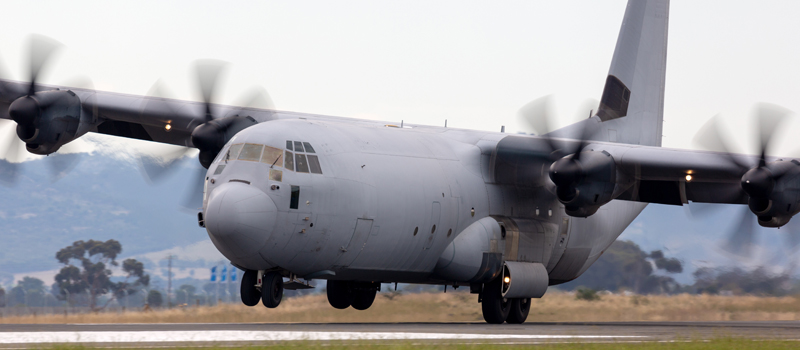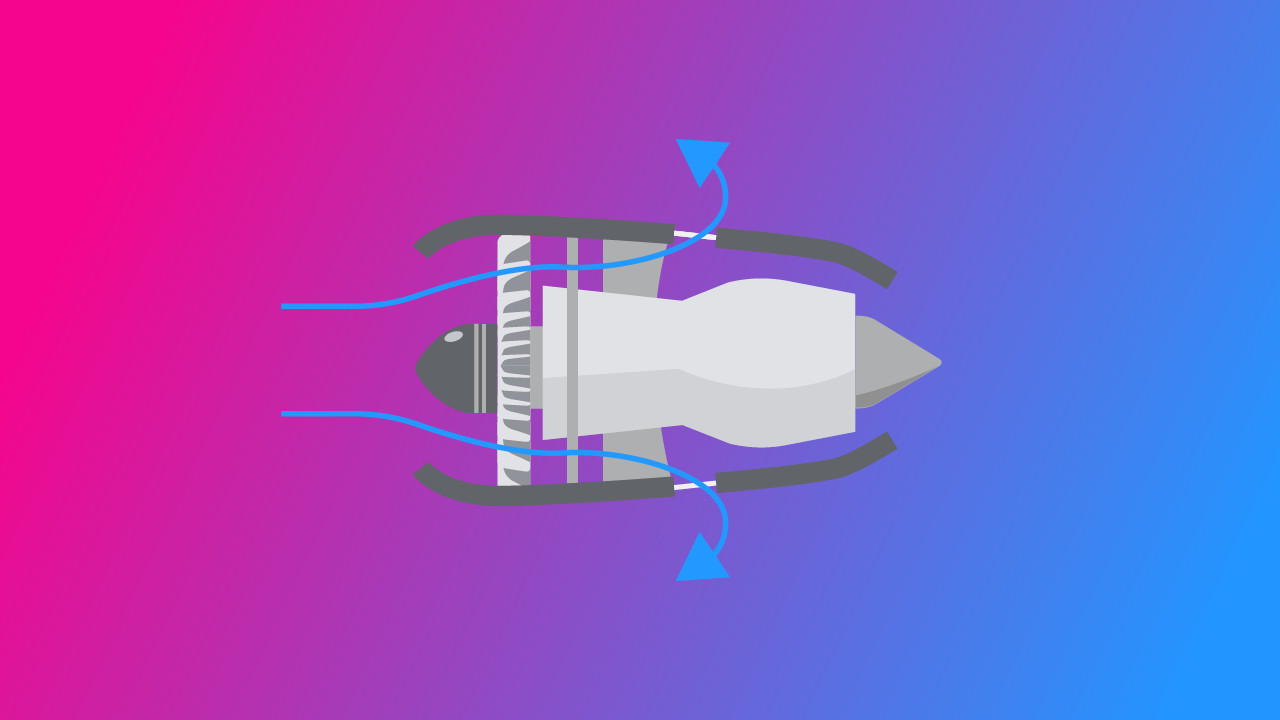-
Key Takeaways
-
What Is TCAS?
- Why Was TCAS Developed?
-
How TCAS Works
- Alerts and Advisories
- Components of TCAS
-
Types of TCAS Systems
- TCAS I
- TCAS II
- TCAS III
-
Operation and Pilot Procedures
- Before Flight / Normal Monitoring:
- Receiving a Traffic Advisory
- Responding to a Resolution Advisory
- Inhibitions and Limitations
-
Regulatory Requirements and Standards
-
Advancements in Collision Avoidance
- Integration with ADS-B
- Future Technologies
-
Conclusion
Pilots constantly watch out of the cockpit windows, and air traffic control monitors traffic in the airspace.
But what happens if the pilots can’t see incoming traffic and ATC somehow misses a potential conflict?
When all else fails, TCAS will alert you and guide you to safety. We’ll explain what it is, how it works, and how it can help keep your aircraft safe.
Key Takeaways
- TCAS involves aircraft transponders interrogating each other to predict a collision course.
- A potential conflict triggers a Traffic Advisory (TA). This could escalate to a Resolution Advisory (RA).
- TAs are only an alert. RAs give explicit coordinated instructions to avoid a collision.
- ACAS X will be dramatically more capable than current versions of TCAS.
What Is TCAS?
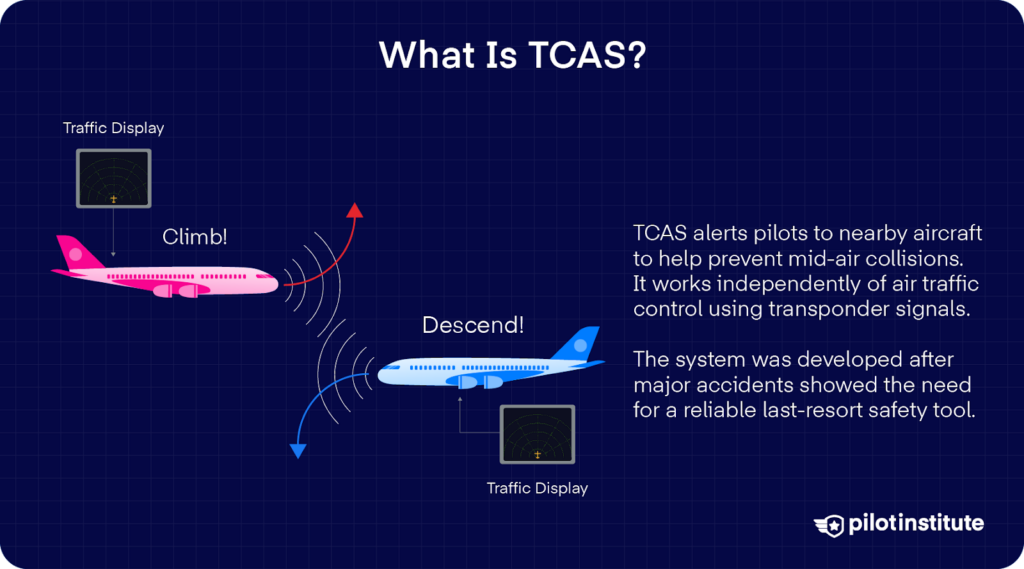
TCAS (Traffic Collision Avoidance System) is an aircraft safety system designed to reduce the risk of mid-air collisions. While TCAS doesn’t maneuver the aircraft itself, it provides alerts and guidance to pilots when another aircraft comes too close for comfort.
Why is TCAS so important?
It’s true that air traffic controllers on the ground keep watch over aircraft in their airspace and make sure they stay safely separated.
Pilots themselves scan for traffic by looking out the cockpit windows.
However, humans and ground radar systems are not infallible. Miscommunications or undetected errors can and do occur.
TCAS serves as a last-resort backup. It works independently of air traffic control and can detect conflicts even if controllers miss them or pilots don’t see them in time.
Why Was TCAS Developed?
The push for an airborne collision avoidance system dates all the way back to the 1950s.
In 1956, a United Airlines DC-7 and a TWA Constellation collided over the Grand Canyon, killing all on board. The scale of the tragedy prompted the aviation industry to explore technology that could prevent mid-air collisions.
A big challenge was getting two aircraft to avoid each other cooperatively. Early concepts couldn’t reliably get both aircraft to agree on avoidance maneuvers. It became clear that any viable system would need some form of communication between the aircraft.
By the 1970s, attention turned to using the signals from transponders to create a collision avoidance system.
Transponders were devices that had become common on many aircraft to make them appear on ATC radar. But how could they help with collision avoidance?
Transponders already transmit an aircraft’s signal when they reply to radar. An onboard system could send its own interrogations and detect those replies.
In 1981, the FAA formally decided to pursue what eventually became TCAS.
How TCAS Works
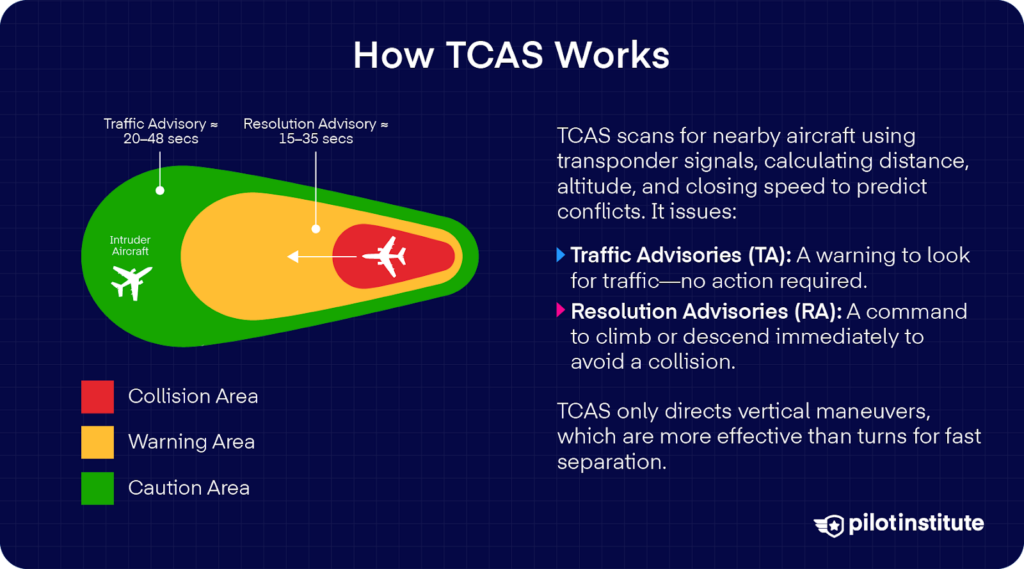
To understand how TCAS works, let’s break it down step by step.
Every TCAS-equipped aircraft actively sends radio signals asking who’s out there and listens for replies. These signals interrogate the transponders of other aircraft nearby.
A transponder responds with identification and altitude data when it receives a radar or TCAS signal.
So, when your TCAS pings the area, any aircraft within range that has its transponder on will answer with its presence and altitude.
- TCAS computes the distance to the other aircraft by timing how long the reply takes.
- It gets the altitude difference by comparing the other aircraft’s reported altitude to your own.
- Using repeated interrogations, TCAS can track the other aircraft’s direction and closing speed.
With this information, the TCAS computer continuously predicts the future path of nearby aircraft relative to your own. When the time of closest approach falls below certain levels, TCAS issues alerts.
Alerts and Advisories
TCAS has two main alert levels corresponding to the two types of advisories:
Traffic Advisory (TA)
A TA is a preliminary warning. It’s TCAS simply giving you a heads-up.
The system will announce “Traffic, traffic,” and on your cockpit display the intruding aircraft will be highlighted (often in yellow).
The display also shows the other aircraft’s relative altitude. For example, “+05” indicates the traffic is 500 feet above you. If the other aircraft is climbing, you’ll see a small arrow pointing upwards next to the number. The arrow points downward if the traffic is descending.
A TA does not tell you how to maneuver; it’s advisory only. The proper pilot response is to start looking for the traffic and be ready if an evasive maneuver becomes necessary. You’re not supposed to deviate from ATC’s instructions on a TCAS traffic advisory.
Resolution Advisory (RA)
If the situation worsens and the distance closes rapidly, TCAS will issue a Resolution Advisory. This is an instruction that must be followed immediately.
An RA triggers at about 15 to 35 seconds to the projected collision point. At this stage, a mid-air collision is imminent unless you take action. TCAS will command an escape maneuver in the vertical direction.
For example, you might hear an audio alert say “Climb, climb!” or “Descend!”. Or it may issue commands like “Monitor vertical speed” or “Maintain vertical speed” if only a slight adjustment is needed.
You also get visual cues on the cockpit display, usually on the vertical speed indicator (VSI). The areas marked red on the VSI show climb or descent rates that can put you on a collision course. Green markings show the climb or safe climb, or descent rates. TCAS RAs can only tell you to climb or descend.
This is by design. In fast-moving aircraft, a sudden turn left or right might not be fast enough to create separation. Vertical maneuvers are more predictable and effective for immediate separation, so TCAS focuses on those.
Components of TCAS
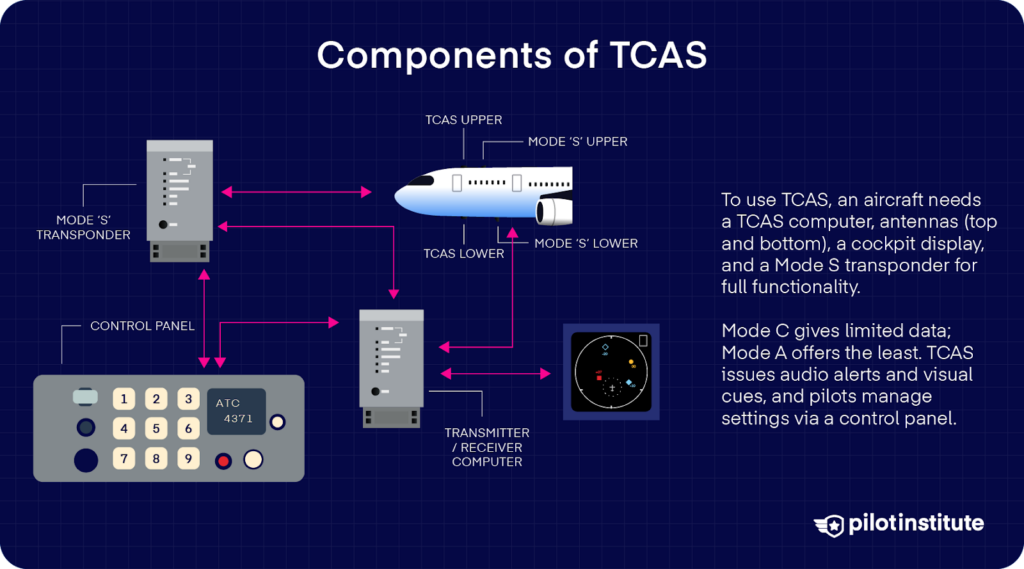
What does an aircraft need to use TCAS?
- TCAS Computer/Processor: Usually installed in the avionics bay, the TCAS computer sends out interrogations, listens to replies, tracks up to dozens of aircraft, and decides when to issue TAs or RAs.
- Transponder: TCAS works in tandem with the aircraft’s transponder. There are different types of transponders, with each having different capabilities. Modern TCAS II systems require you to have a Mode S transponder.
Mode S transponders allow direct TCAS communication between two aircraft.
If you have a Mode C transponder, it can only report altitude and cannot provide TCAS capability. This type can only provide traffic advisories or uncoordinated RAs to the other aircraft.
Mode A transponders are very basic and can’t even report altitude. This type of transponder allows other aircraft to identify your position but not your altitude. - TCAS Antennas: Aircraft usually use two antennas for TCAS. One is typically mounted on top of the fuselage and one on the bottom. These antennas allow TCAS to send and receive signals in 360-degree coverage around the aircraft in both horizontal and vertical directions.
- Cockpit Displays: Modern aircraft typically integrate TCAS traffic right into their navigation display in the cockpit. This display shows where the other aircraft is in relation to you. For example, “Traffic at 2 o’clock, 3 miles, 500 feet below” will be drawn roughly in that relative direction on the screen.
The colored bands appear on the VSI only during an RA. Newer glass cockpits may show this guidance as a flight director cue on the primary flight display (PFD) - Aural Alerts: A synthesized voice will call out “Traffic, traffic” for a TA, and explicit instructions like “Climb, climb” or “Descend, descend now!” for RAs. They’re designed to be attention-grabbing and unambiguous.
- Control Panel/Switches: Pilots can change TCAS settings through a control panel. This is often part of the transponder control head, but can be a separate TCAS control unit. Here, they can set the system’s mode.
- “Standby” turns the TCAS surveillance off. It’s used on the ground or if the system is not needed.
- “TA/RA” is the normal operational mode in flight, in which the system issues both traffic advisories and resolution advisories as needed.
- “TA Only” mode gives you traffic alerts but no automatic RAs. Some models allow adjusting the altitude filter of displayed traffic to focus on threats above or below.
Types of TCAS Systems
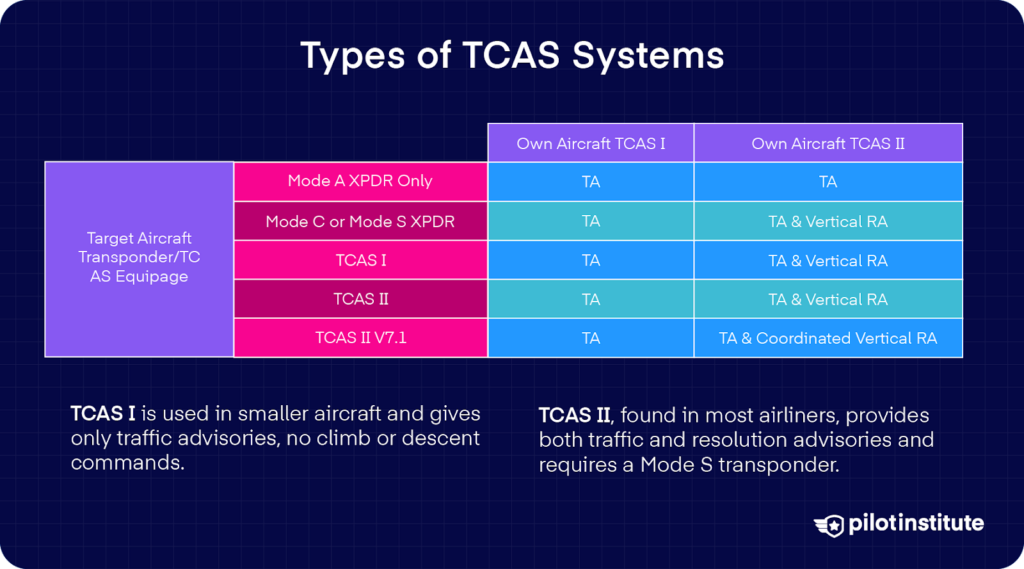
TCAS I
This is a simpler form of the Traffic Collision Avoidance System, typically found in smaller aircraft. This includes some business jets, turboprops, and regional airliners mandated to have it. You can even find it as an optional system in small general aviation aircraft.
TCAS I provides traffic advisories only and no resolution advisories.
It will warn you of nearby transponder-equipped traffic that may be a threat, but it won’t tell you to climb or descend. TCAS I leaves the avoidance maneuver up to the pilot’s judgment.
Technically, TCAS I doesn’t require full Mode S capability. It can work with Mode C transponder replies since it doesn’t coordinate RAs. These days, you may come across models built by Garmin, Avidyne, or others for high-end GA aircraft.
TCAS II
TCAS II is the standard TCAS system used by most modern airliners. It includes coordination between aircraft and offers Resolution Advisories.
TCAS II requires a Mode S transponder to work. You’ll find different software versions within TCAS II. These differences don’t change how a pilot interacts with TCAS. They only make small changes to its programming.
TCAS III
TCAS III was a proposed advanced version of TCAS that was meant to provide horizontal resolution advisories in addition to vertical. The idea was that TCAS III would tell pilots to turn left/right or climb/descend or a combination, selecting the best route in 3D.
Research was done on TCAS III in the late 1980s and 90s, but developing an algorithm that reliably handles horizontal maneuvers turned out to be extremely complex. TCAS III development was discontinued, and it did not enter regular service.
Operation and Pilot Procedures
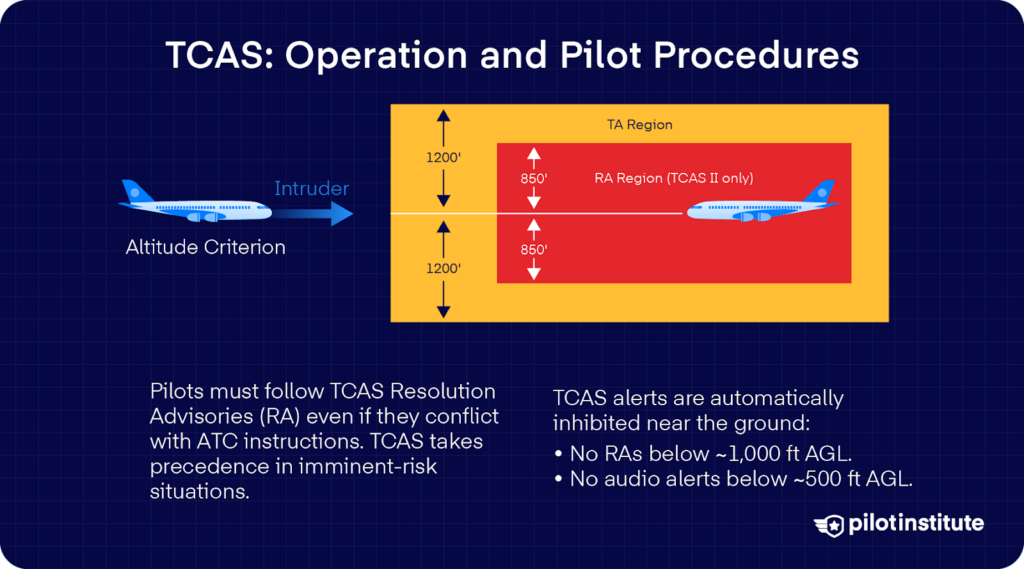
Having TCAS on board is one thing, but knowing how to use it correctly is equally important. Pilots undergo training for TCAS, and there are established procedures on how to respond to its advisories.
Before Flight / Normal Monitoring:
On the ground, TCAS is usually kept on Standby to avoid nuisance alerts on the ground. Pilots switch TCAS to TA/RA when lining up for takeoff.
TCAS keeps monitoring traffic throughout the flight. You’ll see nearby traffic passing by on your display. TCAS won’t alert you as long as the traffic is safely separated, but seeing nearby traffic helps with situational awareness. It also makes it easier to spot traffic when ATC requests it from you.
Receiving a Traffic Advisory
The first sign of potential trouble is the audible “Traffic, traffic” announcement. The intruder causing the TA will turn amber on the display to get the pilots’ attention.
At this point, the pilots simply look for traffic and prepare to maneuver if needed. One pilot usually starts scanning visually in the direction indicated, while the other monitors instruments.
A TA does not mean you’re supposed to deviate from your cleared flight path. The most you can do is pay attention if an RA follows and perhaps double-check that you’re flying correctly at your assigned altitude.
Responding to a Resolution Advisory
If the intruding aircraft keeps getting closer, TCAS will escalate to a Resolution Advisory. An RA means you need to take immediate action. The system will specify what to do via voice command and VSI displays.
Upon hearing an RA, the pilot procedure is to disconnect the autopilot and hand-fly the commanded maneuver.
Why not let the autopilot handle it?
Autopilots aren’t programmed to follow TCAS RAs. Some newer aircraft, such as the A380, do have an automated TCAS mode for autopilots, but that’s the exception. Generally, the pilot is supposed to take control manually because an RA may demand a quicker reaction or more abrupt maneuver than an autopilot would normally perform.
If TCAS commands “Increase climb” or “Increase descent,” it means the initial response wasn’t enough and a steeper change is needed.
One pilot focuses on flying the RA maneuver while the other monitors. As soon as they can, the crew must inform air traffic control that they are deviating due to a TCAS RA. Controllers won’t try to override a TCAS maneuver.
In fact, you’re supposed to follow TCAS instructions even if ATC gives you the opposite command. The 2002 Überlingen mid-air collision happened when one aircraft followed TCAS commands while the other obeyed the controller’s instructions.
TCAS will announce “Clear of conflict” when the danger has passed. At that moment, pilots level off and then inform ATC that they are clear of the other aircraft.
In most cases, the entire TCAS RA episode lasts only a handful of seconds from initial RA to clear-of-conflict.
Pilots practice TCAS encounters in simulators as part of their training. The training emphasizes that in TCAS RA events, react first and ask questions later.
Inhibitions and Limitations
TCAS is programmed to stop giving alerts in certain conditions automatically.
- RAs are inhibited when the aircraft is less than 1,000 feet above the ground. This prevents dangerous maneuvers during takeoff and landing.
- Aural TAs and RAs are both inhibited below 500 feet above the ground. This prevents distractions from nuisance alerts at this critical phase of flight.
Even when TCAS isn’t automatically inhibited, there are situations where it can’t help you.
- If the other aircraft’s transponder is off or disabled, TCAS can’t see it.
- Conversely, situations like approaches in closely spaced parallel runways can have too many nuisance alerts. Pilots may turn off RA and switch to TA-only, following approved procedures.
Regulatory Requirements and Standards
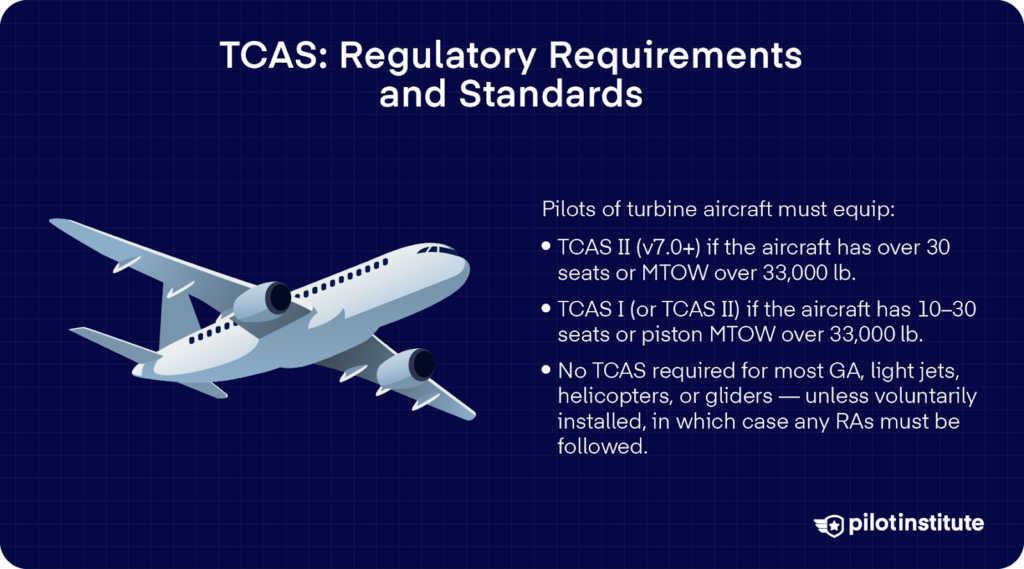
The FAA has a set of rules explaining what type of TCAS your aircraft needs based on seat count and Maximum Takeoff Weight.
- Large turbine aircraft weighing over 33,000 pounds or over 30 passenger seats must carry TCAS II.
- Turbine aircraft with 10 to 30 passenger seats must have at least TCAS I. TCAS II is also allowed.
- Large piston aircraft over 33,000 lb must have TCAS I at least, but they may use TCAS II.
- Whenever TCAS II is used, it has to be version 7.0+
- All other U.S.-registered aircraft do not have to install TCAS. This includes most general-aviation aircraft, light business jets, helicopters, and gliders. If they carry it voluntarily, it must stay on, and any RA must be followed.
- Foreign airlines flying in U.S. airspace follow the same weight and seat rules.
Advancements in Collision Avoidance
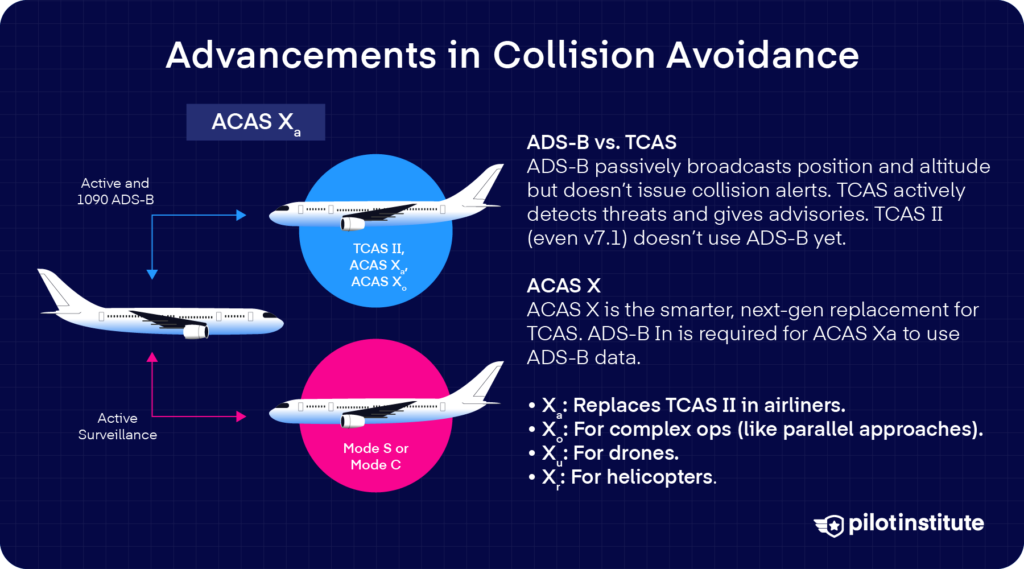
Integration with ADS-B
ADS-B stands for Automatic Dependent Surveillance–Broadcast. It’s a system that allows aircraft to broadcast their position, velocity, altitude, and other data to other aircraft and ground stations.
The difference between ADS-B and TCAS is that the former system is passive. It does not actively interrogate aircraft as TCAS does. That’s why it can’t give any Resolution Advisories.
ADS-B provides more precise, continuous position updates, including aircraft that TCAS might not interrogate at that moment.
However, standard TCAS II (even version 7.1) does not currently use ADS-B inputs. Future versions of TCAS are likely to take advantage of ADS-B.
Future Technologies
ACAS X is a family of new collision avoidance algorithms currently under development by the international aviation sector. The “X” signifies this is a new approach and isn’t just an iteration of TCAS II. ACAS X uses advanced computational methods instead of the existing TCAS’s rule-based logic.
ACAS X has different variants:
- ACAS Xa: This is the direct successor to TCAS II for large transport aircraft. It will perform the same role but with modern computer technology. ACAS Xa is intended to be a plug-in replacement eventually. It’ll use existing transponder signals but make smarter decisions.
- ACAS Xo: The “o” stands for “specific Operations” or “Optional use cases.” This variant is aimed at scenarios that TCAS II doesn’t handle well. This includes closely spaced parallel approaches or operations like overtaking on oceanic routes. ACAS Xo might allow horizontal RA instructions in limited situations.
- ACAS Xu: The “u” stands for Unmanned aircraft systems such as drones. With large drones and remotely piloted vehicles sharing airspace, there’s a need for collision avoidance designed specifically for them.
Drones won’t have pilots to see-and-avoid, so ACAS Xu would serve as their collision avoidance mechanism. It could be integrated into drone autopilot logic to maneuver the drone away from conflicts automatically. - ACAS Xr: The “r” stands for Rotorcraft. Helicopters have different flight characteristics and often operate at lower altitudes or slower speeds where current TCAS isn’t used.
ACAS Xr will provide collision avoidance designed for helicopters. This might include different alerting thresholds since helicopters can turn or stop faster but also often fly low, where TCAS-II might be inhibited. Incidents such as the 2025 Potomac river mid-air collision could potentially be avoided if helicopters use this technology.
ACAS X systems are still in testing and validation stages as of 2025.
Conclusion
TCAS has fundamentally transformed flight safety. Mid-air collisions in controlled airspace are exceedingly rare these days, especially compared to aviation’s pre-TCAS era. Upcoming TCAS models such as ACAS X promise to make flying even safer.
Even so, pilots must not rely on TCAS to bail them out of tight spots. Staying vigilant with seeing and avoiding, along with coordinating with ATC is still what keeps aircraft safely apart.
